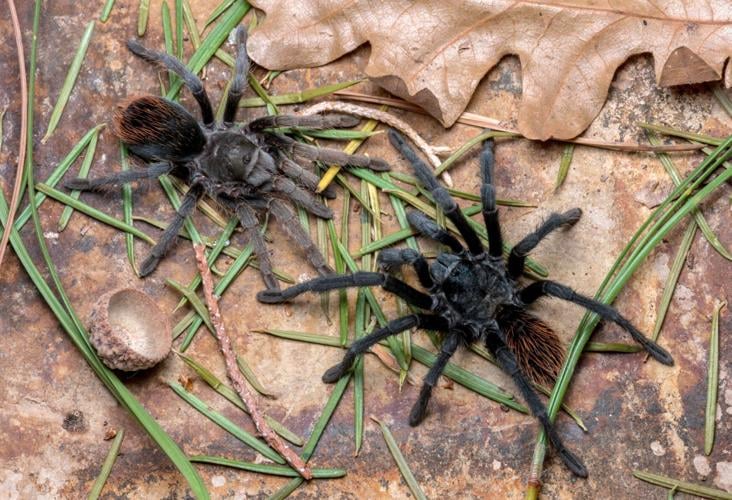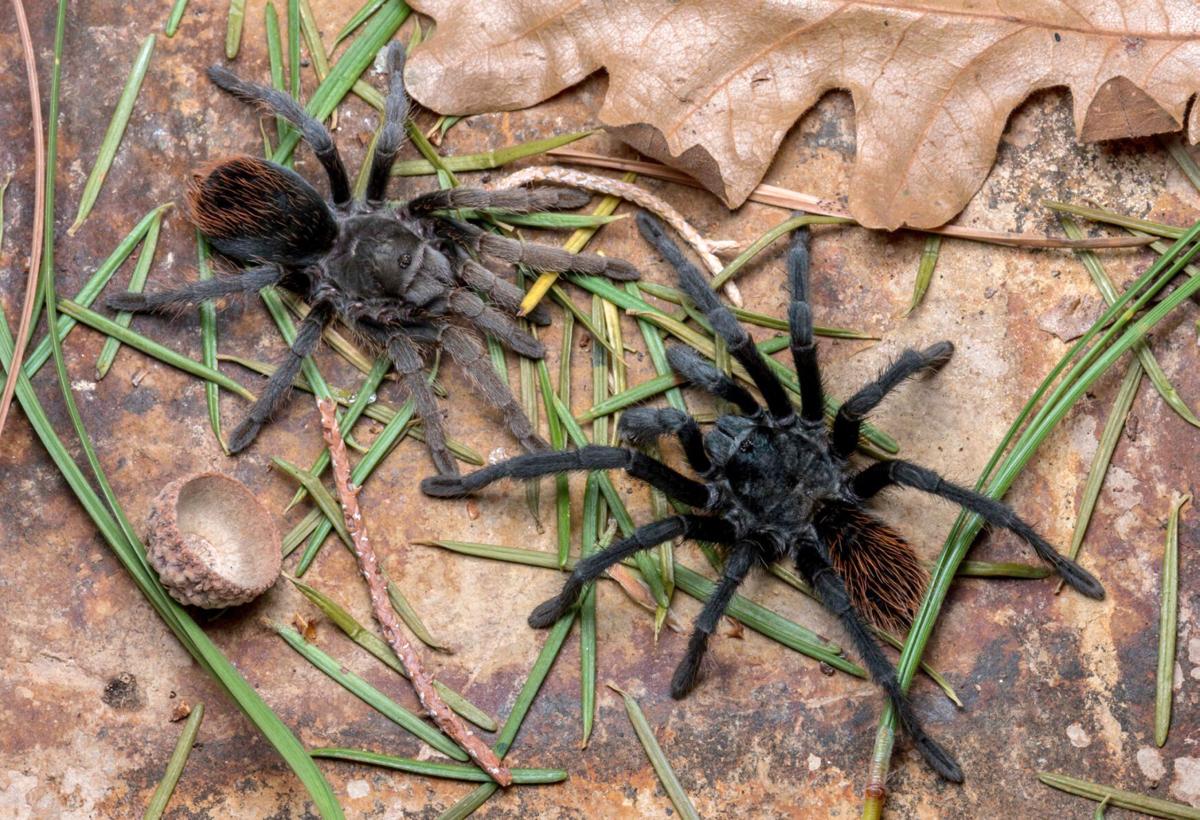Chris Hamilton and Brent Hendrixson met someone unexpected in the mountains of Southeastern Arizona: a leggy redhead with a taste for cold weather.
The two researchers discovered a new species of tarantula that lives high in the Chiricahua Mountains, about 135 miles southeast of Tucson.
The spiders are small as tarantulas go — no more than 2 to 3 inches across, with black and gray bodies accented by fiery orange hairs. Their high-elevation forest habitat requires them to endure frigid winter conditions, but they don’t seem to mind.
“These guys don’t tend to build deep burrows in the ground, either,” said Hamilton, an assistant professor at the University of Idaho. “They appear to be cold-adapted.”
Male spiders have even been seen wandering in the autumn snow in search of a mate.

The newly discovered tarantula has adapted to survive frigid winter conditions near the top of the Chiricahuas.
Hamilton and Hendrixson, a professor at Millsaps College in Mississippi, first observed the tarantulas during a field trip to the Chiricahuas in 2018. They initially mistook the spiders for smaller members of another species found only in the mountain range in Cochise County. Subsequent genetic sequencing confirmed the tarantulas were an entirely different species that had not been described before.
Hendrixson, Hamilton and fellow University of Idaho researcher Karina Silvestre Bringas introduced the new spider to the world last month with an article in the peer-reviewed scientific journal ZooKeys.
They named it Aphonopelma jacobii in honor of Michael Jacobi, a naturalist and photographer who supplied them with their first live specimens while he was working as a volunteer host at the Cave Creek Canyon Visitor Information Center in the Chiricahuas.
If Jacobi had not provided them with the specimens, they might never have determined that the spiders were unique, Hamilton said.
He added that naming new species after people is “one of the nice things we get to do in taxonomy.”
Spider islands
More study is needed to understand the life cycle and behavior of the new species, but if they are like other tarantulas, the average male might live for 5 to 10 years while the females live for 20 years or more, Hamilton said.
Though he couldn’t offer a population estimate for A. jacobii, he said there seems to be plenty of suitable habitats available for the species in the Chiricahuas, including remote areas largely undisturbed by people. “I’d say they are not rare in some of the places where we found them, but they only have this one place to live,” he said.
This is the 15th different tarantula species discovered by Hamilton and Hendrixson, two of the world’s foremost experts in the giant spiders.
Members of the Aphonopelma genus of tarantulas can be found throughout Central America, Mexico and the southern third of the United States, from the Mississippi River west to the Pacific Coast.
“Not a lot of work had been done on these organisms,” Hamilton said, so he and Hendrixson set out to document their diversity and distribution almost 20 years ago.

Researcher Chris Hamilton collects a tarantula in Sonora, Mexico, in an undated photo. Since 2016, Hamilton has been involved in the identification of 15 new species of giant spiders in North America.
“We’ve been working on tarantula biodiversity for a while now,” he said.
The results speak for themselves: Of the 30 known species of tarantulas in the U.S., Hamilton and Hendrixson discovered half of them.
In 2016, the two scientists teamed up with researcher Jason Bond on a paper describing a whopping 14 new Aphonopelma species, nine of which are found only in Arizona.
That includes four species named for the “sky islands” where the spiders live: A. catalina, A. chiricahua, A peloncillo and A. superstitionense.
They also identified two other new tarantulas in the mountains surrounding Tucson: A. madera, named for Madera Canyon in the Santa Ritas, and A. saguaro, named for Saguaro National Park, where they have been documented in the foothills of both the Rincons and the Santa Catalinas.
Cuddly crawlers
The researchers have gotten creative with the names of a few of their eight-legged discoveries. One new species is called A. atomicum because it lives near the entrance to the Nevada National Security Site, a tightly guarded patch of desert northwest of Las Vegas where more than 900 nuclear tests have been conducted.
And A. johnnycashi got its name because Hamilton is a huge fan of the legendary singer-songwriter. Also, he said, the males of the species “are ‘dressed in black’ and found around Folsom prison” in the western foothills of California’s Sierra Nevada Mountains.
Tarantulas are “teddy bear spiders,” as far as Hamilton is concerned.
“They’re a charismatic organism,” he said. “I’ve handled thousands of them, and I’ve never been bitten. They’re pretty laid back.”

This is a mature male from the new species of tarantula, known by the scientific name Aphonopelma jacobii.
Tom Weaver is curator of herpetology, ichthyology and invertebrate zoology at the Arizona-Sonora Desert Museum. He wasn’t involved in the tarantula research, but he isn’t surprised to see new spider species turning up in southern Arizona.
Weaver said advances in DNA analysis have prompted scientists to redraw whole limbs on the taxonomic tree of life. Some species once thought to be distinct have been lumped together under a single scientific name, while others have split off into new species based on percentage-point differences in their genetic codes.
That might sound like splitting hairs — fiery orange ones, in this particular case — but the more we learn about the natural world, the better equipped we are to conserve it, Weaver said.
“They’re pushing the envelope of our knowledge,” he said of researchers like Hamilton and Hendrixson. “It’s cool.”
Its last legs?
There is intrinsic scientific value in cataloging new species, Hamilton said. “Taxonomy is about understanding the true diversity of life on the planet. That is the basis for all of biology.”
Documenting individual organisms is also an important way to assess the health of the places where they live — in this case, the so-called Madrean Archipelago, a chain of mountain ranges rising up from a sea of desert and arid grassland in Arizona, New Mexico and Sonora.
Those isolated sky islands have given rise to “an unusually high percentage of endemic species” that have evolved their own distinct genetics and behaviors, Hamilton said. “They are one of the planet’s biodiversity hotspots. There’s just tremendous diversity there.”
But there is also trouble.
“This is a place that’s being hit extremely hard by climate change,” he said.
Rising temperatures and shifting precipitation patterns spurred by human-generated greenhouse gas emissions are already altering plant communities in these mountain ranges. Over the past 50 years or so, Hamilton said, the region’s Madrean oak-pine woodlands have been pushed roughly 1,000 feet higher than they used to be. If the warming trend continues, this unique habitat could eventually run out of higher places to climb to.
It turns out that tarantulas are a good way to model what’s happening.

This is a female from the new species of tarantula, known by the scientific name Aphonopelma jacobii.
“These kinds of spiders don’t move very much. They’re closely tied to their habitats,” Hamilton explained. “If you can understand their history, that helps you understand the history of the sky islands themselves.”
So, the search for more spiders has become a race against time.
“If you’re missing too many pieces, it’s hard to see the story of the whole puzzle,” Hamilton said. “We’re scrambling to find some of these species, so we can try to understand them before they’re gone.”









